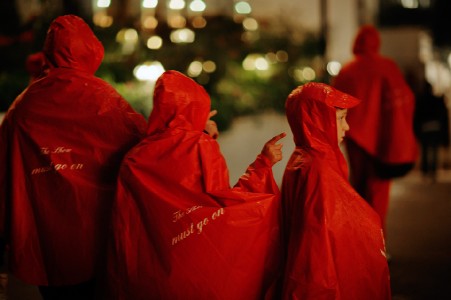Birgitta Lund’s photographic investigation of Copenhagen’s Tivoli Gardens is a complex and thought-provoking visual narrative about people and the meeting of cultures – about our preconceptions and the power of fictions.
By Mai Misfeldt
There are dark pictures among the images Birgitta Lund has gathered in her book The Garden. But also images penetrated by violent flashes of light. Whether from fireworks or the explosions of war, is impossible to see. Their subject is people, people looking. What they’re looking at, what they’re witness to, is not visible. They stand together or alone.
They could be anticipating something, they could be alarmed, which in itself is disturbing - that you don’t know, that the images can’t be pinned down, that they provide no answers as to whether the illuminated skies they’re looking at hold beauty or dread. In other images we see fragments of a Middle Eastern backdrop- a half moon, an illuminated minaret. We also see images of people concentrating on shooting or controlling something.
When ‘the Orient’ was Exotic
The people in the images are perfectly ordinary people of many races, which makes it difficult to identify the location. But as the book’s text reveals, the photographs were taken at Tivoli Gardens in the heart of Copenhagen.
What we’re witness to is not war, but fun and fireworks and the delight and frisson of both. The architectural background is the oriental scenery of the Tivoli Gardens, echoing the time when the Orient was a seductive idea in the West, associated with pleasure and sexuality, as opposed to dominant, contemporary narratives of religious extremism and terrorism.
Funfair visitors love ‘the oriental’ in the Tivoli Gardens, without ever thinking about how they really relate to many Danish citizens’ roots in that culture, and that that very culture is no longer the object of much aesthetic fascination in the West.
Lund’s images make the extent to which the Tivoli Gardens are an anachronism apparent. It may be an appealing anachronism, but we also need images that reveal the fictional scaffolding of our lives, and question how consistent it is with the other fictions currently dominating Western society.
‘Real Indians’
Georg Carstensen’s Tivoli Gardens opened in 1843, inspired by romantic amusement parks elsewhere in Europe. Today, the Tivoli Gardens are more than an amusement park – those there are many of. What makes the Tivoli Gardens special is that they’re also a historical site. The aesthetic contemplation of flowers and dream buildings from distant shores has always had a prominent place at the Tivoli Gardens.
Which goes back to the end of the 1800s, when the Orient became fashionable in the West, and when the Tivoli Gardens were a place where it could be cultivated in a visual universewhere ideas about the Orient and the exotic were expressed in new, fantastical set designs.
This was also the time of human exhibitions, major crowd-pullers where people flocked to the zoo and Tivoli Gardens to see the real, live black people, Indians or Chinese families literally on display. Two centuries later times have changed, but some of the old props are still standing. Without them Tivoli Gardens would just be another fun fair.
Denmark at War
The photographer Birgitta Lund has a long-held interest in the Tivoli Gardens and the clash between reality and dreams they represent.
In the book’s introductory conversation with her friend the documentary filmmaker Brian Palmer, she tells us that the project started when she returned to Denmark after living in New York for 20 years. The Denmark she returned to was a different country to the one she’d left: a country at war, a country where the polarisation between ‘them’ and ‘us’ had grown, a country permeated by a fear she didn’t associate with the tolerant country she remembered.
In her poetic, expressive interpretations Lund focuses on visitors to the gardens – primarily children and young people – as both passive observers and active participants. A man taking aim with his back to the camera. A young woman holding her hand over her mouth in disbelief. Muslim women behind a lattice gate. The flash of explosions in the skies. Rain at night. A boy staring trancelike at a gaming machine, another hiding his face against an adult chest turning a single, wide eye towards something we can’t see.
Poetic Duality
We don’t see what they see, only their faces - their eyes. This is where we find the source of the fascination in Lund’s images. That horror and entertainment can look so alike. That the image of the dark-haired man aiming a gun automatically generates media stereotypes of other dark-haired men taking aim. That it would maybe be perceived differently if it was a fair-haired man? One becomes uncomfortably aware of one’s own prejudices when looking at Lund’s images. Lund is interested in the fiction of the Tivoli Gardens: a staged microcosm, a miniature world within the world, they are the perfect context for the images she wanted to make.
Despite the fact that she uses reality and takes pictures of people who don’t known they’re being watched, the work is not documentary photography. It is, instead, a complex and thought-provoking visual narrative about people and the meeting of cultures. About conceptions and the power of fictions.
The Garden has been published by Space Poetry – a beautiful book with resounding images of the highest quality.
Translation by Jane Rowley

